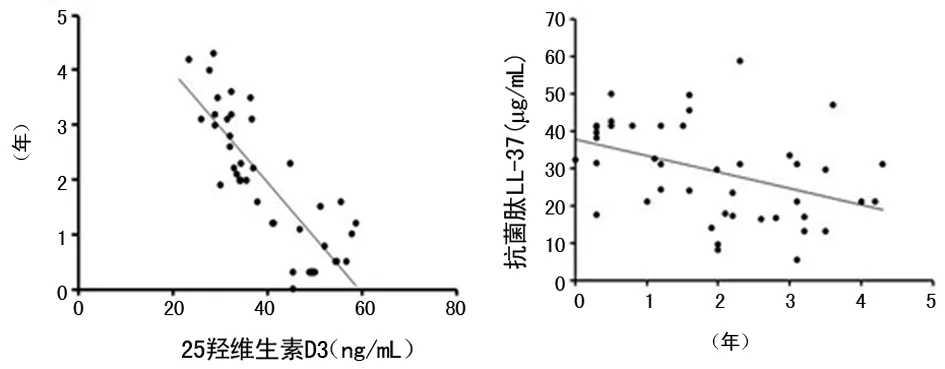25羟维生素D3与抗菌肽在反复上呼吸道感染中的作用研究及相关性分析*
2016-12-19罗光燕杨小琼王孝芸袁谢芳李国平
罗光燕,杨小琼,张 芸,王孝芸,袁谢芳,王 星,李国平,△
(1.西南医科大学卫生科,四川泸州 646000;2.西南医科大学附属医院炎症与变态反应实验室,四川泸州 646000;3.西南医科大学附属医院呼吸内科,四川泸州 646000)
论著·临床研究
25羟维生素D3与抗菌肽在反复上呼吸道感染中的作用研究及相关性分析*
罗光燕1,2,杨小琼3,张 芸3,王孝芸2,袁谢芳2,王 星2,李国平2,3△
(1.西南医科大学卫生科,四川泸州 646000;2.西南医科大学附属医院炎症与变态反应实验室,四川泸州 646000;3.西南医科大学附属医院呼吸内科,四川泸州 646000)
目的 探讨25羟维生素D3与抗菌肽在反复上呼吸道感染的作用。方法 选择连续3年就诊的上呼吸道感染患者,其中,1年上呼吸道感染次数大于或等于2次患者46例,男20例,女26例,平均(32.35±9.10)岁;选择15例人作为对照组,平均(31.35±10.20)岁,对照组在年龄上与上呼吸道感染患者差异无统计学意义(P>0.05)。采用酶联免疫吸附测定(ELISA)检测外周血血清中25羟维生素D3水平和诱导痰上清液抗菌肽LL-37水平并做相关性分析。用人气道上皮细胞株分析25羟维生素D3对抗菌肽LL-37水平影响。结果 反复上呼吸道感染患者外周血血清25羟维生素D3水平低于对照组(P<0.05),并且反复上呼吸道感染患者诱导痰上清液人抗菌肽LL-37水平低于对照组(P<0.05)。上呼吸道感染平均次数与上呼吸道感染患者外周血25羟维生素D3呈负相关(r=-0.54,P<0.05),上呼吸道感染平均次数与诱导痰上清液抗菌肽LL-37水平呈负相关(r=-0.65,P<0.05),上呼吸道感染患者外周血25羟维生素D3和诱导谈上清液抗菌肽LL-37水平呈正相关(r=0.59,P<0.05)。体外细胞实验显示1,25羟维生素D3能上调上皮细胞抗菌肽LL-37表达。结论 25羟维生素D3的缺乏可能是上呼吸道反复感染患抗菌肽LL-37的表达下调的重要原因。
反复上呼吸道感染;25羟维生素D3;抗菌肽LL-37
上呼吸道感染是常见疾病呼吸系统疾病,其常见病原微生物多为鼻病毒、腺病毒、流感病毒、副流感病毒,肠病毒和呼吸道合胞病毒等,细菌感染多继发于病毒感染。研究表明血清25羟维生素D3缺乏与反复呼吸道感染有关,25羟维生素D3水平与肺部感染和肺功能下降存在明显相关性[1]。维生素D3补充能有效减少上呼吸道感染反复发生。新生儿25羟维生素D3缺乏明显增加上呼吸道感染次数和风险,孕妇补充25羟维生素D3有助于减低反复上呼吸道感染风险[2]。呼吸道感染发生同样与肺部固有免疫有关,已有研究表明抗菌肽LL-37是固有免疫的重要效应分子[3]。25羟维生素D3通过维生素D受体调节固有免疫,促进抗菌肽LL-37的表达,从而增强机体的抗感染能力。25羟维生素D3能诱导抗菌肽表达,然而在上呼吸道反复感染中,维生素D与LL-37的相关性仍不明确[4-7]。故笔者通过分析上呼吸道反复感染患者外周血血清中25羟维生素D3水平和诱导痰上清液人抗菌肽LL-37水平,分析其相关性,以探讨25羟维生素D3、LL-37之间相关性和上呼吸道反复感染之间的相关性。
1 资料与方法
1.1 一般资料 共收集2011年6月至2014年1月在西南医科大学卫生科就诊上呼吸道感染患者1988例,男896例,女1092例,平均(35.24±10.88)岁,均为选取连续3年在本科就诊的上呼吸道感染患者。其中,1年上呼吸道感染次数大于或等于2次患者46例(感染组),男20例,女26例,平均(32.35±9.10)岁。上呼吸道感染诊断标准:(1)起病急,并伴有发热、咳嗽、流鼻涕、鼻塞,喷嚏等症状;(2)体格检查仅发现咽部充血和或扁桃体肿大;(3)外周血白细胞计数及分类正常或偏低、或偏高。选取15例健康人作为对照组,男7例,女8例,平均(31.35±10.20)岁。对照组在年龄与上呼吸道感染患者差异无统计学意义(P>0.05)。全部上呼吸道感染组患者均不伴有其他免疫功能受影响的疾病。
1.2 方法
1.2.1 反复呼吸道感染次数 根据患者近3年发生上呼吸道感染次数,取平均值统计。
1.2.2 标本收集与处理 抽取空腹静脉血,分离血清,-70℃保存;用4%氯化钠溶液雾化吸入5~10min,痰液收集于无菌容器中,保存于4℃冰箱。在1h内处理,加入4倍重量的0.1%二硫苏糖醇(DTT),置于37℃水浴箱5min,吹打致黏液完全溶解,2500r/min离心10min,上清液置于-70℃保存。
1.2.3 细胞实验 选取人气道上皮细胞株(16HBE,本实验室保存),加入含10%胎牛血清的DMEM/F12培养基,在37℃和5% CO2的细胞培养箱中培养,更换为无血清DMEM/F12培养基。分别用磷酸盐缓冲液(PBS),25羟维生素D3(10nmol/L)刺激细胞24h后收集细胞进行检测。实验均重复3次。对照组用25羟维生素D3抑制剂-伊曲康唑预处理2h后,用25羟维生素D3(10nmol/L)刺激细胞。
1.2.4 细胞蛋白和总RNA的提取及浓度测定 刺激细胞24h后,弃去培养基,无菌PBS洗涤细胞2次,用细胞刮收集细胞于无菌EP管中,用细胞裂解液或RNA提取试剂盒(RNAfast200试剂盒),按照说明书提取蛋白和RNA。
1.2.5 酶联免疫吸附测定(ELISA) 采用ELISA检测外周血血清中25羟维生素D3水平,人抗菌肽LL-37水平, 25羟维生素D3ELISA试剂盒购于德国IBL公司,人抗菌肽ELISA试剂盒购于美国RD公司。实验方法参照说明书。
1.2.6 实时荧光定量PCR(RT-PCR)检测细胞LL-37的mRNA水平 LL-37引物上游为:5′-GTC ACC AGA GGA TTG TGA CTT CAA-3′,下游引物为5′-TTG AGG GTC ACT GTC CCC ATA-3′。内参照甘油醛-3-磷酸脱氢酶(GAPDH)上游引物为:5′-GGA GTC AAC GGA TTT GGT CGT A-3′;下游为5′-GCA ACA ATA TCC ACT TTA CCA GAG TTA A-3′。引物由上海生工生物工程有限公司合成。用鸟类成髓细胞瘤病毒逆转录酶(AMV-RT)使用oligo dT引物扩增cDNA,LL-37引物和GAPDH引物完成 PCR 实验,GAPDH作为内参照。

2 结 果
2.1 两组25羟维生素D3和抗菌肽LL-37水平比较 外周血血清25羟维生素D3水平位为(39.94±10.20)ng/mL,对照组为(65.60±9.20)ng/mL,反复上呼吸道感染患者外周血25羟维生素D3水平位低于对照组(P<0.05)。反复上呼吸道感染患者诱导痰上清液抗菌肽LL-37水平为(8.90±0.54)μg/mL,对照组为(30.12±0.98)μg/mL,反复上呼吸道感染患者诱导痰上清液抗菌肽LL-37水平高于对照组(P<0.05),见表1。

表1 两组外周血25羟维生素D3和抗菌肽LL-37水平比较
2.2 感染组外周血25羟维生素D3和诱导痰上清液抗菌肽LL-37水平与反复上呼吸道感染的相关性分析 46例连续3年在本科就诊的上呼吸道感染患者,3年内上呼吸道感染总次数除以3为3年内上呼吸道感染平均次数,上呼吸道感染平均次数与上呼吸道感染患者外周血25羟维生素D3呈负相关(r=-0.54,P<0.05);上呼吸道感染平均次数与诱导痰上清液抗菌肽LL-37水平呈负相关(r=-0.65,P<0.05),见图1。

图1 25羟维生素D3和诱导痰上清液抗菌肽LL-37水平与反复上呼吸道感染相关性分析
2.3 感染组外周血25羟维生素D3和诱导痰上清液抗菌肽LL-37水平相关性分析 反复上呼吸道感染患者外周血25羟维生素D3和诱导痰上清液抗菌肽LL-37水平相关性分析(r=0.59,P<0.05),表明反复上呼吸道感染患者外周血25羟维生素D3和诱导痰上清抗菌肽LL-37水平呈正相关,见图2。

图2 外周血25羟维生素D3和诱导痰上清液抗菌肽LL-37水平相关性分析
2.4 25羟维生素D3上调抗菌肽LL-37的表达 为进一步分析25羟维生素D3对抗菌肽LL-37表达影响,选取气道上皮细胞株16HBE,用25羟维生素D3刺激人支气管上皮细胞后,收集细胞提取总RNA经逆转录,通过ELISA测定LL-37蛋白浓度和RT-PCR检测LL-37的mRNA表达。与PBS相比,25羟维生素D3能显著增加IL-37蛋白浓度(P<0.05),同时能增加LL-37mRNA水平(P<0.05),而25羟维生素D3抑制剂能降低25羟维生素D3诱导的IL-37蛋白浓度和LL-37mRNA水平。
3 讨 论
反复上呼吸道感染是常见疾病呼吸系统疾病,病因复杂,其临床特点为反复上呼吸道感染,病程较长,缺乏特殊的治疗方法。近年研究表明,呼吸道反复感染与维生素D缺乏有明显相关性[1]。抗菌肽LL-37作为维生素D受体信号通路的下游分子,其在机体抗感染方面的作用得到了格外关注,然而抗菌肽LL-37在上呼吸道反复感染中的作用尚不明确[8-9]。本研究比较了呼吸道反复感染患者和健康人群25羟维生素D3与抗菌肽LL-37的水平,并分析了反复上呼吸道感染患者外周血25羟维生素D3和诱导痰上清液抗菌肽LL-37水平与反复上呼吸道感染的相关性。结果显示,反复上呼吸道感染患者外周血血清25羟维生素D3水平显著低于对照组,上呼吸道感染平均次数与上呼吸道感染患者外周血25羟维生素D3呈负相关,表明血清25羟维生素D3缺乏可能与反复呼吸道感染有关,进一步验证了血清25羟维生素D3在抗感染中的作用。
抗菌肽LL-37在肠道、气道、皮肤等处表达形成抵抗细菌的第1道防线[10]。其表达调控具有复杂的机制,且在不同的细胞类型和环境中其表达受到不同的调控,维生素D受体直接调节抗菌肽表达,25羟维生素D3显著上调骨髓细胞抗菌肽表达[10-12]。已有研究表明,抗菌肽LL-37作为固有免疫的效应分子和执行分子,特别是在炎症和受伤的部位其表达受促炎细胞因子,细胞因子,细菌产物等一系列刺激因素的上调[13]。研究发现反复上呼吸道感染患者诱导痰上清液抗菌肽LL-37水平显著低于对照组,上呼吸道感染平均次数与诱导痰上清液抗菌肽LL-37水平呈负相关。本研究结果提示,上呼吸道反复感染导致的抗菌肽LL-37水平显著降低可能是患者反复呼吸道感染的重要因素。
此外,已有研究表明,维生素D的活性形式25羟维生素D3是抗菌肽的潜在诱导因子,其可通过与维生素D受体结合,促进抗菌肽的表达[14-15]。而本研究结果显示,反复上呼吸道感染患者外周血25羟维生素D3和诱导痰上清液抗菌肽LL-37水平呈正相关,表明25羟维生素D3的缺乏引起抗菌肽LL-37的水平降低。25羟维生素D3缺乏引起的上呼吸道反复感染患者,25羟维生素D3缺乏降低维生素D-维生素D受体信号通路促进抗菌肽LL-37的表达。同时通过细胞实验进一步分析表明25羟维生素D3能上调抗菌肽LL-37表达。
本研究揭示了血清25羟维生素D3缺乏与反复呼吸道感染之间的联系。同时,本研究发现在上呼吸道反复感染中,25羟维生素D3的缺乏是抗菌肽LL-37的表达下调的直接原因。然而,上呼吸道反复感染患者诱导痰上清液抗菌肽LL-37水平显著升高的机制需进一步研究。
[1]Bozzetto S,Carraro S,Giordano G,et al.Asthma,allergy and respiratory infections:the vitamin D hypothesis[J].Allergy,2012,67(1):10-17.
[2]Belderbos ME,Houben ML,Wilbrink B,et al.Cord blood vitamin D deficiency is associated with respiratory syncytial virus bronchiolitis[J].Pediatrics,2011,127(6):e1513-1520.
[3]田万红,喻钢.抗菌肽LL-37功能研究综述[J].药物分析杂志,2014,34(10):1890-1896.
[4]Yim S,Dhawan P,Ragunath C,et al.Induction of cathelicidin in normal and CF bronchial epithelial cells by 1,25-dihydroxyvitamin D(3)[J].J Cyst Fibros,2007,6(6):403-410.
[5]Wang TT,Nestel FP,Bourdeau V,et al.Cutting edge:1,25-dihydroxyvitamin D3is a direct inducer of antimicrobial peptide gene expression[J].J Immunol,2004,173(5):2909-2912.
[6]Schrumpf JA,van Sterkenburg MA,Verhoosel RM,et al.Interleukin 13exposure enhances vitamin D-mediated expression of the human cathelicidin antimicrobial peptide 18/LL-37in bronchial epithelial cells[J].Infect Immun,2012,80(12):4485-4494.
[7]Heilborn JD,Weber G,Gronberg A,et al.Topical treatment with the vitamin D analogue calcipotriol enhances the upregulation of the antimicrobial protein hCAP18/LL-37during wounding in human skin in vivo[J].Exp Dermatol,2010,19(4):332-338.
[8]Zhang C,Zhao L,Ma L,et al.Vitamin D status and expression of vitamin D receptor and LL-37in patients with spontaneous bacterial peritonitis[J].Dig Dis Sci,2012,57(1):182-188.
[9]SatoE,ImafukuS,IshiiK,etal.VitaminD-dependentcathelicidininhibitsMycobacteriummarinuminfectioninhumanmonocyticcells[J].JDermatolSci,2013,70(3):166-172.
[10]Vandamme D,Landuyt B,Luyten W,et al.A comprehensive summary of LL-37,the factotum human cathelicidin peptide[J].Cell Immunol,2012,280(1):22-35.
[11]Park K,Elias PM,Oda Y,et al.Regulation of cathelicidin antimicrobial peptide expression by an endoplasmic reticulum (ER) stress signaling,vitamin D receptor-independent pathway[J].J Biol Chem,2011,286(39):34121-34130.
[12]Gombart AF,Borregaard N,Koeffler HP.Human cathelicidin antimicrobial peptide (CAMP) gene is a direct target of the vitamin D receptor and is strongly up-regulated in myeloid cells by 1,25-dihydroxyvitamin D3[J].FASEB J,2005,19(9):1067-1077.
[13]Bucki R,Leszczynska K,Namiot A,et al.Cathelicidin LL-37:a multitask antimicrobial peptide[J].Arch Immunol Ther Exp(Warsz),2010,58(1):15-25.
[14]Adams JS,Liu PT,Chun R,et al.Vitamin D in defense of the human immune response[J].Ann N Y A Sci,2007(1117):94-105.
[15]Nijnik A,Hancock RE.The roles of cathelicidin LL-37in immune defences and novel clinical applications[J].Cur Opin Hematol,2009,16(1):41-47.
The role and correlation analysis between 25-hydroxy vitamin D3and human cathelicidin in recurrent upper respiratory infection*
Luo Guangyan1,2,Yang Xiaoqiong3,Zhang Yun3,Wang Xiaoyun2,Yuan Xiefang2,Wang Xing2,Li Guoping2,3△
(1.Hygiene Section,Southwest Medical University,Luzhou,Sichuan 646000,China;2.Inflammation & AllergicDiseases Research Unit,First Affiliated Hospital of Southwest Medical University,Luzhou,Sichuan 646000,China;3.Department of Respiratory,First Affiliated Hospital of Southwest Medical University,Luzhou,Sichuan 646000,China)
Objective 25-hydroxy vitamin D3as a key innate immune signaling,which can promote the expression of antimicrobial peptide LL-37.This study was to explore the role of 25-hydroxy vitamin D3and LL-37in the recurrent upper respiratory tract infection.Methods The patients with upper respiratory tract infection in our department for three consecutive years were selected.The prevalence frequencies of 46patients with upper respiratory tract infection were greater than or equal to two times one year (20male patients and 26female patients).The average age was (32.35±9.10)years old.15cases of healthy people were regards as a control group,and the average age was (31.35±10.20)years old.The age was no significant difference between the patient with upper respiratory tract infection and control group(P>0.05).The level of 25-hydroxy vitamin D3and human antimicrobial peptide LL-37in peripheral blood serum and supernatant of induced sputum were detected with ELISA.The correlation analysis was done with SPSS software.The effect of 25hydroxy vitamin D3on the level of LL-37in the antimicrobial peptide were analyzed by human airway epithelial cell line.Results The levels of 25-hydroxy vitamin D3from peripheral blood serum in patients with upper respiratory tract infection were significantly lower than the healthy control group(P<0.05).The levels of LL-37in patients with upper respiratory tract infection were significantly decreased,compared with healthy control group(P<0.05).The prevalence frequencies of upper respiratory tract infection were negatively correlated with the levels of 25-hydroxy vitamin D3(r=-0.54,P<0.05),and prevalence frequencies of upper respiratory tract infection were also negatively associated with levels of antimicrobial peptide LL-37(r=-0.65,P<0.05).The levels of 25-hydroxy vitamin D3were positively correlated with levels of antimicrobial peptide LL-37(r=0.59,P<0.05).In vitro cell experiments showed that 25-hydroxy vitamin D3upregulated the expression of LL-37in cells.Conclusion 25-hydroxy vitamin D3deficiency may down-regulate antimicrobial peptide LL-37in recurrent upper respiratory tract infection.
recurrent upper respiratory tract infection;25-dihydroxy vitamin D3;LL-37
10.3969/j.issn.1671-8348.2016.29.007
国家自然科学基金资助项目(81170032)。 作者简介:罗光燕(1968-),主治医师,本科,主要从事呼吸疾病基础与临床研究。△
R562.2+1
A
1671-8348(2016)29-4053-03
2016-02-25
2016-04-13)
